Are you a runner? Well, guess what? Wearing compression socks can actually help with performance!
According to news and publishing, running while wearing compression socks may bring along several health benefits. They help prevent injury, increase blood flow, and recover after activity.
Read on to learn what you need to know about adding graduated compression socks to improve your workouts by activity and healthy habits. We’ll share the benefits of graduated compression socks, how to wear them and how they have grown in popularity as a safe preventative and recovery method for athletes.
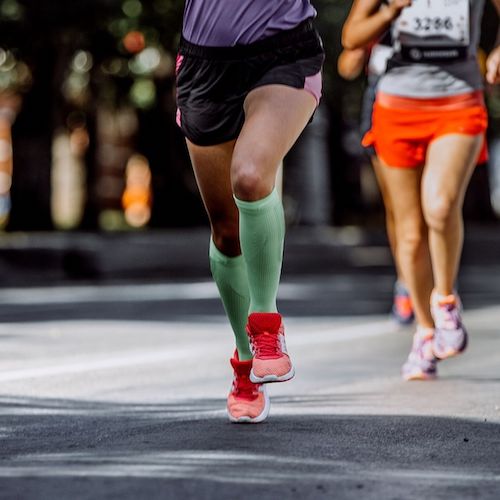
Why Should You Add Compression Socks When You Run?
There are many benefits to compression running socks, including:
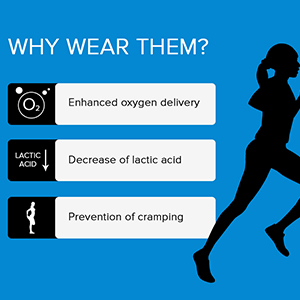
Enhanced Oxygen Delivery
One of the most critical aspects of your health and performance is ensuring there is enough blood-rich oxygen flowing to your muscles every time you go on a run.
One of the worst bit experiences for marathon, 5k, or 10k runners is losing their calf muscle strength before the finish line.
A high-quality compression sock is critical for ensuring your legs have optimal oxygen health delivery for the entire race. The purpose of a good compression sock is to provide compression gradually. They could mean that the knee high socks run a bit looser on the top and tighter at the bottom. This graduation is what ensures proper circulation.
Less Impact from Gravity
Another benefit of graduated compression socks is that they help your legs fight off the impact of gravity when your blood returns to your heart. The stockings create pressure that helps to push fluid up your legs. The increased blood flow creates a steady supply of essential oxygen and nutrients for your legs when you most need it.
Prevention of Swelling and Cramps
The most common reason for calf muscle fatigue is excess movement. The pressure from compression socks decreases this movement to help keep you energized.
Consequently, wearing good compressing knee high socks can also reduce the amount of effort required of your legs. When your muscles are not working quite as hard, the impact of fatigue to better your health is effectively reduced.
Furthermore, medical compression socks can help control leg, ankle, and foot swelling such as plantar fasciitis as well as varicose veins. As the socks squeeze all of these areas, where they prevent fluid buildup.
Related: Best Socks for Swollen Feet
Decreased Lactic Acid
Every time you exercise or run, your body produces a waste produce called lactic acid. If you allow the lactic acid to remain in your muscles, you are going to be extremely sore when you wake up the next morning. Most runners are all too familiar with this problem.
The good news is that the constriction of graduated compression socks can prevent blood clot and reduce this soreness and help to prevent it from happening in the first place. There’s no need to put off that five-mile run you had been looking forward to!
Enhanced Blood Flow
Proper compression narrows your veins and helps with improved blood flow. This prevents blood clot. Your blood will reach your heart more quickly, and lactic acid will be removed more quickly. If you are competing in a marathon, this is absolutely critical.
Leg Protection
Compression stockings protect your legs from abrasions and small scratches. If there is poison ivy on your running trail, you will not need to worry. Additionally, any dirt or mud kicked up during your run will collect on your socks instead of your legs.
Warmth
A lot of runners are more comfortable wearing shorts. When the weather is warmer, this is an excellent option. It can sometimes cause problems for runners in cooler weather, however, especially for those who do not like to wear tights.
Yet, it is still important that the muscles in your legs stay warm to prevent muscle strain. In addition, heat can relax tight muscles and aid in the removal of lactic acid. Wearing compression socks can help to keep your legs warm, even in the coldest months.
Other Popular Articles on ComproGear
Rose Toy Rose Vibrators Review
Wearing Compression Run Socks to Help with Health, Training and Recovery from an Intense Activity
The effects of compression on recovery, health and performance have been studied in numerous trials already, but what are compression socks? Research is still being done on the effects of compression for runners and other athletes.
New evidence has shown that using compression can be just as effective for running as it is for recovery after vein or leg surgery.

In the past, compression socks were mainly used in the medical field, by doctors and a nurse. They have been prescribed for decades to prevent and treat circulatory system issues and vein diseases. They are often used by those who have limited mobility or who are confined to bed.
The Importance of Athletic Compression Socks for Health, Training and Fitness
It’s important to understand the basics of improved blood flow in recognizing the difference that compression knee high socks socks and compression sleeves can bring for athletes.
Your heart is responsible for pumping oxygen-rich blood to your muscles and limbs by way of the arteries. Once your cells absorb the nutrients and oxygen, the blood is sent back to your heart through the veins.
Before the cycle starts again, however, the lungs must replenish the oxygen and nutrients in your blood. This entire process is of critical importance for athletic performance.
Running with Medical Compression Socks and Sleeves
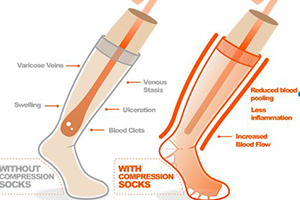
Serious athletes are always looking for new ways to improve their performance and hone their skills. Though compression knee high socks provide numerous benefits, the idea is still new to many runners.
Medical compression therapy keeps your body in alignment, decreases your exercise recovery time, prevents you from wasting energy and improves your training efficiency and performance.
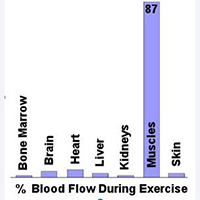
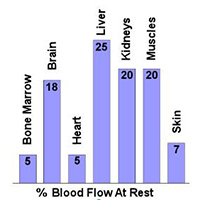
Athletic compression socks apply graduated pressure that is tighter at the angles and less tight at the knee. This type of pressure is a key component of reported performance benefits.
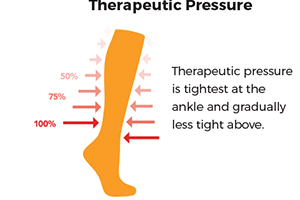
The compression on the leg’s surface veins, muscles, and arteries enables the blood to circulate through smaller circulatory veins.
It could mean that the blood can return to the heart more quickly, decreasing the chances of it pooling in the feet. It also aids in the elimination of lactic acid.
Wearing support medical sleeves or socks helps blood circulate better throughout the legs. Better circulation increases cellular oxygen, which improves cell function. This results in superior training and recovery for runners.
Compression Socks Help with Injury and Recovery
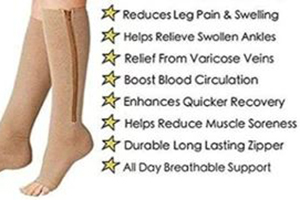
The Science of Running claims that one of the reasons is because they provide a major athletic performance boost is that they decrease muscle vibration during a run. This can both increase leg power and reduce the post-workout soreness.
Another important benefit is that athletic compression socks reduce the risk of shin splints and plantar fasiitis. If you have ever had shin splints, then you already know all about the aching pain they send up your calves every time you run. It can feel like they take a lifetime to heal!
Perhaps you have heard that the best treatments for shin splints are elevating the legs, applying ice, resting, and not running until your body had fully healed.
What many people do not realize by activity, however, is that the right compression stockings can also help to speed up that long recovery process!
Since they provide stability and support for your lower leg, compression stockings help to alleviate the bone and muscle strain caused by shin splints. While it is not a magical cure, this added step in recovery can get you back to your favorite athletic activities more quickly.
A full sock is preferable to a sleeve for shin splint recovery because the arch support will provide additional pain relief.
How to Choose the Best Medical Compression Socks for Running and Training
- Since everyone’s legs are different, medical running socks come in different sizes and compression levels to match calf and foot measurements. They are available in both men’s and women’s styles.
The level of compression that you need depends on numerous factors, including the size, style, and material of the stockings.
- Your personal preferences also play a role. It is important to remember that you do not want to wear medical running gear that is too tight, otherwise, it will cause pain and bad odour. This can actually make blood circulation worse and injury recovery longer.
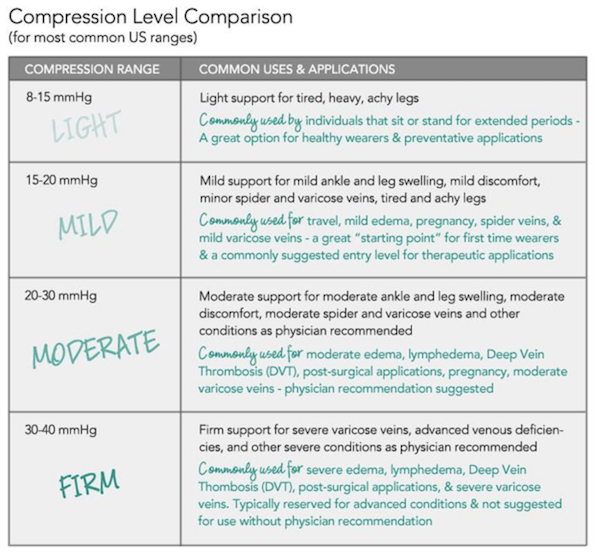
- Good pairs are composed of both fibers and rubber, which gives them a firmer feel than traditional ones. They are most commonly 20 percent spandex and 80 percent nylon.
- Although both women’s and men’s running medical compression stockings are available in different lengths, the best ones for running should rise to just below your knees.
- You will need to find the correct level of pressure, which is measured in millimeters of mercury, or mmHg. The lower the number, the milder the compression.
Properly fitted socks should squeeze and feel snug but not painfully tight. Although personal preference plays a role in selecting a compression level, an improperly fitted sock will cause pains or be ineffective. Most runners prefer a sock with a pressure of 20-30 mmHg.
- It is also important to find the right size and length. This is done by measuring the calves. Thus, be sure to choose your running gear with fabric and texture that feels comfortable.
- You will need to select different pairs for warmer and cooler weather. Fortunately, these come in a wide variety of materials including cotton, wool, spandex, nylon, polyester, and lycra.
How to Put Compression Socks On

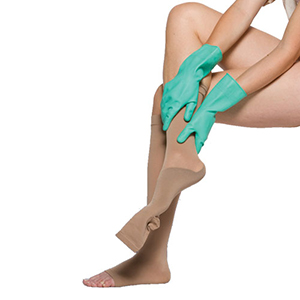
Most of the medical gear for activity, fitness, cycling, and recovery use graduated medical compression. This means they are tighter at your ankle and less tight at your knee. Unfortunately, while this helps circulation, it can also make them difficult to put on. For best results, smooth out socks carefully to eliminate any bunching.
Many people roll these down because they are too long. When you are wearing compression socks, however, that is like putting a tourniquet on your leg.
You will restrict your blood flow and injure yourself, especially during intense activity, such as a 5k or 10k race, a marathon or a cycling event. Save yourself the risk by getting socks that are the correct length.
Related Articles
Extra Wide Calf Compression Socks Compression Socks for Large Calves
Old Man Compression Socks Best Compression Socks for Elderly with Swollen Feet
Gout Friendly Socks Socks for Gout
Studies of Athletic Compression Gear
There are a lot of well-known runners who swear by the study and its benefits, including the former record holder for the American 10,000 meters, Chris Solinsky.
Other top runners such as the latest women’s marathon record holder, Paula Radcliffe, along with four-time Olympian, Jo Pavey and the Australian long-distance runner Benitta Johnson would never go without them.
By activity and studies, both conducted in laboratory and field settings – test the effects of athletic compression gear. The trials tested different variables, including the type used, the material, the distance where the run had taken place and the fitness level of the participants.
None of the studies showed negative results. Some even showed a positive correlation between athletic performance and compression.
Studies of Compression Stockings, Socks and Their Effect on Athletic Performance
The majority of studies and publishing conducted using real athletes as the participants have found performance benefits directly linked to compression. When all of the studies are considered, the results generally agree that compression stockings offer benefits for recovery.

Although the study does not agree on the reason, most found that muscle fatigue and soreness were decreased by using compression socks running.
Compression gear also provided quicker lactate recovery. Also, every study agreed that the compression must be graduated to provide many benefits for the athlete.
The compression should be strongest at the ankle, and pressure should decrease as the height of the sock increases.
Many athletes strongly believe that these boost their performance and recovery speed. It is becoming more popular as more people report how it has helped with their calf strain and soreness.
Just remember that consistency is key if you really want to benefit from compression socks. This means you need to wear them every time you go for a run. This is the best way to ensure a speedy recovery.
No Adverse Effects from Compression Have Been Reported

- Compression socks running may provide you with the competitive edge you have been looking for and do not cause bad foot odour.
- If you are interested to look for when improving your performance when you run, there is no reason not to give them a try.
- Make certain to find the size and length of the proper stocking based on your specific measurements, then see what kind of difference it makes.
This page last updated November 5, 2022
